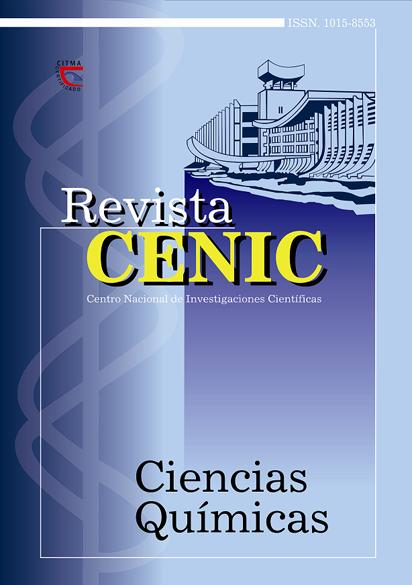Chemical characterization of rhamnolipids produced by Pseudomonas aeruginosa AT10 from residue soybean oil by HPLC-EM
Abstract
The hybridization liquid chromatography-mass spectrometry is applied for the characterization of hormones,
drugs, rhamnolipids and other compounds. The rhamnolipids are microbial tensoactives produced by Pseudomonas aeruginosa
with different substrates. The soybean oil waste contains linoleic (48.4 %) and oleic (21.1 %) acids fundamentally. In
this work was determined the chemical and structural composition of the rhamnolipids of the Pseudomonas aeruginosa
AT10 with soybean oil waste utilizing instrumental hybridization High Pressure Liquid Chromatography-Mass Spectrometry.
The structural characterization of the rhamnolipids evidenced the presence of eight peaks that correspond to
the dirhamnolipids (51.5 %) R2C10C10; R2C10C12:1; R2C10C12 and the monorhamnolipids (48.5 %) R1C10C10; R1C10C12:1; R1C10C12;
R1C12:2; R1C8:2. The negative electrospray visualized that the most abundant fragmentation in the monorhamnolipids
was the corresponding to the [M–H]- 169, in the homologous RhaC10C10, RhaC10C12 and RhaC10C12:1, that corresponding
to the pseudomoleculars ions [M–H]- 503, 531 and 529 respectively. For the dirhamnolipids RhaRhaC10C10, RhaRhaC10C12
and RhaRhaC10C12:1, it was observed that the pseudomolecular ion [M-H]- 649, 675 and 677, respectively, was the most
abundant peak The fragmentation of the ester link permitted to separate monorhamnolipids and dirhamnolipids among
themselves and identified him at the specific isomer in the four equal isomers RhaC10C12/RhaC12C10, RhaC10C12:1/RhaC12:1C10,
RhaRhaC10C12/RhaRhaC12C10, RhaRhaC10C12:1/RhaRhaC12:1C10. The hybridization HPLC/MS permitted to evaluate also the
accumulation out of every counterpart during the time of cultivation. In the first 24 h only were detected the rhamnolipids
RhaRhaC10C10 and RhaC10C10.

Downloads
Published
How to Cite
Issue
Section
License

This work is licensed under a Creative Commons Attribution-NonCommercial-ShareAlike 4.0 International License.
Los autores que publican en esta revista están de acuerdo con los siguientes términos:
Los autores conservan los derechos de autor y garantizan a la revista el derecho de ser la primera publicación del trabajo al igual que licenciado bajo una Creative Commons Atribución-NoComercial-CompartirIgual 4.0 que permite a otros compartir el trabajo con un reconocimiento de la autoría del trabajo y la publicación inicial en esta revista.
Los autores pueden establecer por separado acuerdos adicionales para la distribución no exclusiva de la versión de la obra publicada en la revista (por ejemplo, situarlo en un repositorio institucional o publicarlo en un libro), con un reconocimiento de su publicación inicial en esta revista.
Se permite y se anima a los autores a difundir sus trabajos electrónicamente (por ejemplo, en repositorios institucionales o en su propio sitio web) antes y durante el proceso de envío, ya que puede dar lugar a intercambios productivos, así como a una citación más temprana y mayor de los trabajos publicados (Véase The Effect of Open Access) (en inglés).













